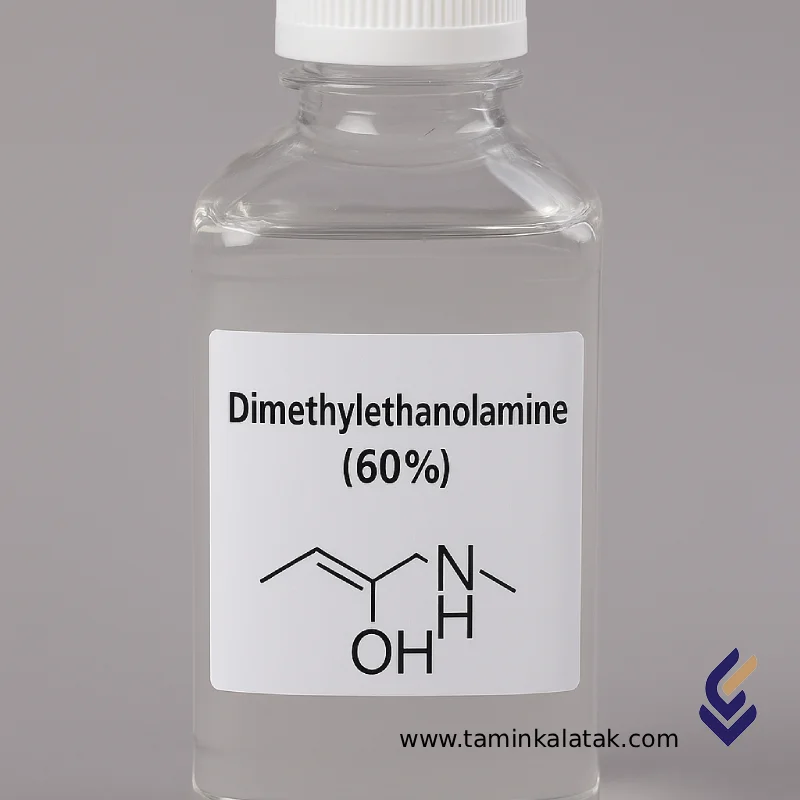Di Methylene Amine 60%
N,N-Dimethylethanolamine (DMAE) — also known as Dimethylaminoethanol or DMEA — is a tertiary amine–primary alcohol compound, typically supplied as a 60% aqueous solution.
It is industrially produced by the reaction of dimethylamine with ethylene oxide.
DMAE is a versatile intermediate widely used as a reactive agent, emulsifier, catalyst, and pH modifier in various industries including resins, gas treatment, coatings, and personal care.
Chemical Structure
-
Molecular Formula: C₄H₁₁NO
-
Molecular Weight: 89.14 g/mol
-
Semi-Structural Formula: (CH₃)₂N–CH₂–CH₂–OH
-
IUPAC Name: 2-(Dimethylamino)ethanol
-
Chemical Family: Alkanolamines
Physical and Chemical Properties
| Property | Specification |
|---|---|
| Appearance | Clear to pale-yellow liquid |
| Odor | Ammonia- or fish-like odor |
| Boiling Point (99% grade) | 134–136 °C |
| Solubility | Completely miscible with water (commonly supplied as 60% aqueous solution) |
| pH (10% solution) | ~3 |
| Flash Point (closed cup) | ~39 °C (flammable liquid) |
| Refractive Index (20 °C) | nD ≈ 1.438–1.439 |
Key Advantages
-
Dual functionality (amine + alcohol) — provides high reactivity for a wide range of chemical syntheses
-
Effective CO₂ absorber in gas sweetening and refining processes
-
Strong base for pH adjustment in formulations
-
Excellent water solubility — easy incorporation in aqueous and solvent-based systems
-
Useful synthetic intermediate for pharmaceuticals, surfactants, and polymers
Limitations & Precautions
-
Corrosive to skin, eyes, and respiratory tract
-
Flammable liquid with a low flash point (~39 °C)
-
May form carcinogenic nitrosamines in contact with nitrites
-
Strong odor at high concentrations
-
Requires careful storage and handling due to volatility and reactivity
Industrial Applications
-
Detergent & Personal Care Industry: buffering and emulsifying agent
-
Paints & Resins: catalyst and pH regulator in coatings, polyurethane, and resin systems
-
Gas Treatment: acid gas (CO₂, H₂S) absorption agent
-
Chemical Intermediate: precursor for pharmaceuticals, surfactants, and specialty polymers
-
Electronics & Specialty Chemicals: used in precision synthesis and fine chemical manufacturing
Safety and Handling
GHS Classification:
-
⚠️ Signal Word: DANGER
-
H226: Flammable liquid and vapor
-
H302: Harmful if swallowed
-
H312: Harmful in contact with skin
-
H314: Causes severe skin burns and eye damage
-
H332: Harmful if inhaled
-
Classification: Skin Corr. 1B, Eye Dam. 1, Acute Tox. 3 (inhalation)
Recommended PPE:
-
Nitrile or butyl rubber gloves
-
Chemical splash goggles or face shield
-
Protective clothing
-
Adequate ventilation or respirator in confined areas
Storage Conditions:
-
Store in tightly sealed containers below 30 °C
-
Keep away from heat, sparks, and open flame
-
Avoid contact with acids, oxidizing agents, and nitrites (risk of nitrosamine formation)
-
Ensure dry, well-ventilated storage area
Emergency Measures:
-
Skin Contact: Wash immediately with soap and plenty of water
-
Eye Contact: Rinse thoroughly with clean water for at least 15 minutes; seek medical attention
-
Inhalation: Move to fresh air; provide oxygen if needed
-
Spillage: Contain and absorb with inert material; dispose of safely per local regulations
Summary
DMAE 60% is a multi-functional tertiary amine and alcohol widely used as a catalyst, emulsifier, and reactive intermediate in coatings, gas treatment, and specialty chemical production.
Its strong alkalinity and high water solubility make it valuable in industrial formulations, provided that proper safety and storage measures are observed.
Applications
| Applications | , , , , |
|---|
Di Methylene Amine 60%
| Products | Melting point | Solubility in water | Density (at 20°C) | Physical appearance | Vapor pressure | Grade | CAS number | Chemical formula |
|---|---|---|---|---|---|---|---|---|
| N,N-dimethylethanolamine | ≈ −70 °C | Completely soluble (any ratio), available on the market as a 60% solution | 0.886 – 0.889 g/cm³ (pure) | Colorless to pale yellow liquid, ammonia/fishy odor | ~ 6.1 mmHg (816 Pa) | Industrial, laboratory, high purity 98–99% in Sigma-Aldrich grade | 31/12/0107 | C₄H₁₁NO |







